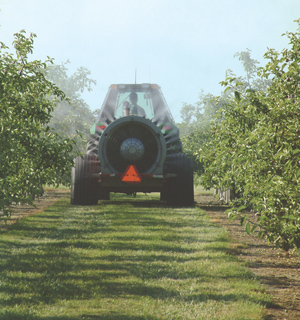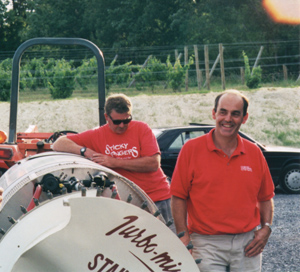
Equipment
Storage
Targeting air-blast sprayers
There are many factors to consider for effective pesticide application plus ways to improve coverage of the target crop
March 12, 2008 By Hugh McElhone
There are many
factors to consider for effective pesticide application plus ways to
improve coverage of the target crop, says Dr. Andrew Landers of Cornell
University in Geneva, N.Y.
 |
| Public perception has become a big factor when it comes to spraying vineyards and orchards and there is also concern about spray drift. All growers have their own perception of drift, and while air blast spraying has many positives, it can also be the biggest culprit of spray drift. Photo by Margaret Land |
There are many factors to consider for effective pesticide application plus ways to improve coverage of the target crop, says Dr. Andrew Landers of Cornell University in Geneva, N.Y.
One such factor is labeling information. Water volumes and application rates on the label do not change as the plant grows but should be adjusted accordingly as the crop gets bigger.
With grapes, the row spacing and height of the trellis system can be a factor, as well as the timing of the application and drift. On the equipment side, are the tractor and sprayer suitably matched for the job? Dr. Landers, a pesticide application technology specialist, also asks if the sprayer operator is well trained on the equipment and fully understands the point of spraying.
Public perception has become a big factor, and Dr. Landers notes that many consumers do not think grapes are sprayed. Having a giant pesticide plume over a roadside vineyard does not make for great public relations, he adds.
All growers have their own perception of drift, and while air blast has many positives, it is also the biggest culprit of drift. Dr. Landers notes that many sprayers are too big for modern planting systems and the oversized fan diameter creates too great a volume of air for the size of the crop.
He acknowledges that many growers are reluctant to replace mechanically reliable equipment so many sprayers are more than 10 years old. Modern sprayers, on the other hand, use a variable pitch propeller that can change the volume of air to match the crop as it grows. Newer models also have adjustable deflectors at the outlet to better direct the flow of air into the crop.
 |
| Dr. Andrew Landers is a pesticide application technology specialist with the Department of Agricultural and Biological Engineering at Cornell University. He also does work at the New York State Agricultural Experiment Station in Geneva, N.Y. Contributed photo |
Forced air is needed to penetrate the canopy and drive the droplets to the target. Dr. Landers notes, however, that too much shaking can occur forcing the droplets to blast past the intended target only to land in the neighbour’s field or the municipal watercourse. Freshly lain droplets can also be washed off when the sprayer passes from the opposite direction on the next row.
Researchers estimate approximately 30 per cent of the spray mixture is lost when air-blast sprayers overshoot the top of the crop. This has been a concern in the European Union (EU) for quite some time and Germany, for one, requires air-blast sprayers to be tested every three years with a vertical patternator.
The “patternator” has sensor plates mounted at various heights on a vertical frame. This frame rides a rail past the stationary sprayer at speeds used in the field. The blue dye mixture in the tank hits the sensor plates and is collected in corresponding beakers to show the spray pattern, volumes at different heights in the crop as well as overspray.
Dr. Landers and his team built a similar device last summer using frame mounted household screens set at various heights with measuring pails to collect the solution as the sprayer drove by. Their homemade “patternator” achieved results similar to the German model.
Due to the counter-clockwise turn of the fan, airflow is always strongest on the top right of the sprayer, as their tests confirmed. To counter this pattern, Dr. Landers says a grate that equalizes airflow is available from Italy for about $4,000 or you can build your own, which is what Dr. Landers did.
Calling it the “Cornell Doughnut,” his crew made a plywood cutout that tightly fit the air intake of the sprayer. A smaller hole cut in the centre restricts the volume of air and reduces drift to two rows when the crop is young. As the crop fills in, a doughnut with more holes is used until maturity, when the doughnut is removed altogether.
Considering the direction of the airflow, Dr. Landers says you can reduce drift and still hit the target by plugging the top two nozzles on the right boom, and angling the next two downward into the crop. Similarly, the bottom two nozzles on the left side can be angled upward at 45 degrees to counteract the downward direction of the airflow.
The air induction nozzles commonly used in weed control can reduce air-blast drift to three or four rows versus seven rows for hollow cone tips. There has been some discussion of better leaf coverage with air induction but Dr. Landers would like to see more testing done.
Reducing P.T.O. speed by 25 per cent, from 540 to 410, or powering the fan with a variable speed hydraulic motor can also reduce drift. Dr. Landers says manufacturers have jumped on the bandwagon and introduced adjustable louvres for cutting air output plus top deflectors that can be fitted to older sprayers for aiming the flow down into the row.
The tunnel sprayer, which air blasts one row from both sides simultaneously, remains the best machine on the market at the moment, says Dr. Landers. It has 90 per cent less drift which means 90 per cent target accuracy. With such thorough coverage, pesticide volume rates can be reduced, which translates into lower product costs.
For those growers not quite prepared to make the jump to the tunnel sprayer, these are just a few of the things they can do to improve the performance of their older ones. “Do whatever you need to do to get the optimal volume to cover your target,” says Dr. Landers, and you will not only reduce your costs but drift as well, he concludes.
Print this page